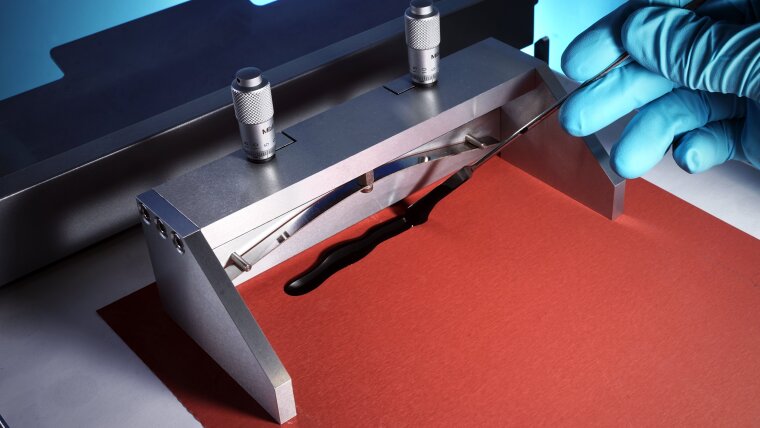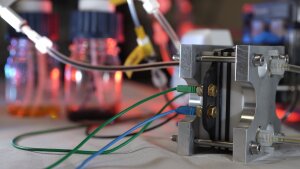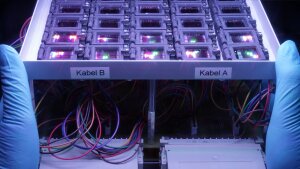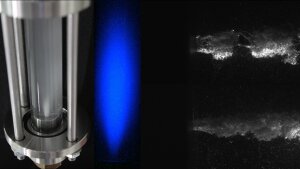
Our research activities focus on new and progressive approaches in the areas of energy storage, light-energy conversion and clean tech.
In all three fields, the CEEC Jena can rely on a broad expertise in the development of different materials - from ceramics over glasses to carbons as well as polymers.
In addition, we have extensive expertise in the characterization of the materials across different length scales from the molecular level, e.g, using spectroscopic methods, to macroscopic material investigation, e.g., by means of scattering methods. The achieved characteristics of the developed materials are of high interest regarding their application in energy storage systems as well as in the entire field of electrochemistry.
Graphic "Our Research"
Image: FSU Jena / Martin Hager, Alexandra Lex-Balducci-
(Printable) film batteries
In organic radical batteries (ORBs) organic polymers are used on active electrode material. These are based on so-called stable organic radicals – molecules with at least one unpaired electron – and replace critical heavy metal compounds such as the cobalt-containing cathode material in lithium-ion batteries. Therefore, ORBs are of low risk and sustainable. In addition, they are characterized by a high power density, fast charging processes (within a few minutes) and long lifetimes. In principle, these thin batteries can be produced by means of printing techniques.
New active materials as well as optimized electrolytes for ORBs are being developed at the CEEC Jena.
-
Solar batteries
Solar batteries are hybrid systems that combine a solar cell for energy production with a battery for storage of the produced energy. In such systems, the power generated by the solar cell can both supply consumers and be stored directly by the integrated battery. If there is no sunlight, the battery takes over the power supply. The development of these systems is still at a fundamental level.
At the CEEC Jena, we are researching the development of organic solar batteries, i.e., the combination of organic solar cells with organic film batteries.
-
Sodium-ion batteries
Sodium-ion batteries are considered as a pioneering technology in the area of stationary battery storage technology. The basic idea is to replace the undesired resource lithium with sodium – a resource that is a thousand times more abundant on earth than lithium. Next to the better availability of the element, another advantage of using sodium-based batteries is the opportunity for simplified recycling at the end of their service life. The key challenge of the technology is to control thermal processes and corrosion, thereby ensuring cycle stability and system safety. In addition, efforts are being made on an international level to make this system ready for mass-implementation and to compensate for disadvantages like size, weight and lower operating voltage. Potential applications for the various types of sodium ion batteries are stationary storage applications, for example, as storage tanks for wind turbines and solar systems.
Both high-temperatureExternal link and room temperature systemsExternal link are being investigated at the CEEC Jena.
-
Polymer-based redox flow batteries
Redox flow batteries (RFBs) are electrochemically reversible cells based on active materials that are dissolved in liquid solvents. The two so-called electrolytes (catholyte and anolyte) are stored in separate tanks and pumped for charging and discharging in an electrochemical cell where the redox reactions are taking place. The big advantage of RFBs is the independent scalability of capacity and power. The key challenge is to develop RFBs which do not rely on rare and therefore expensive substances (e.g., vanadium compounds) or corrosive solvents (e.g., sulfuric acid). At the same time, the systems have to be stable, cost-effective and scalable in the long term.
At the CEEC Jena, materials and concepts for significantly improved RFBs are investigated with the aim of developing easily manageable, safe and at the same time economical energy storage systems. One approach is the use of polymeric active materials, which allow the use of inexpensive dialysis membranes instead of expensive ion-selective membranes. Additionally, vanadium compounds and sulfuric acid can be replaced by polymers and aqueous saline solution, respectively.
-
Supercapacitors
Electrochemical double layer capacitors (EDLCs, or supercapacitors) are mainly used in high power applications like e.g., for defibrillators. In EDLCs the energy is stored through a physical process, the double-layer formation, which occurs between the electrodes and the ions of the electrolyte. Since the double layer formation is a very fast process – it can take place in the millisecond time frame – EDLCs can be charge and discharge in very short time (seconds or less) and display extremely high power (10 kW kg-1). Moreover, since this physical storage process does not imply (theoretically) any structural change and it can take place with very high efficiency, EDLCs also display extremely high cycle life (lifetime >500000 cycles). The energy of these devices is in order of 5 Wh kg-1.
At the CEEC Jena both novel and innovative electrolytes and nanostructured and carbon-based electrode materials for supercapacitors are developed.
-
Cavitation
Cavitation describes the formation, growth and implosive collapse of vapor or gas bubbles in a liquid. It creates chemical and physical effects, which are used in a broad range of applications. Chemical effects are accompanied by the so-called hot spots, which are located in the center of the collapsing bubbles and show temperatures up to 5000 K and high pressures up to 1000 atm. As a result, pyrolytic degradation of volatile organic compounds (VOCs) as well as the homolytic cleavage of water molecules inside the hot spot occur. The formed hydroxyl radicals with their high oxidation potential are able to degrade micropollutants like pharmaceuticals and hormones, effectively. Therefore, the cavitation process belongs to the Advanced Oxidation Processes (AOP). The physical effects of cavitation are mainly based on shear forces and micro streams, which form the so-called micro jets at phase boundary layers. Thus, cavitation shows a great potential for different mixing and cleaning processes and is able to accelerate mass transport limited reactions.
In our working group hydrodynamic as well as acoustic cavitation and their combination as a hybrid method, the so-called Hydrodynamic-Acoustic-Cavitation (HAC) are used in different research fields. Mainstay is the acoustic or optical cavitation field analysis with hydrophones and chemiluminescence and the reactor development/optimization for specific applications.
At the CEEC, cavitation technologies are applied in the process intensification of different transport limited reactions or multiphase systems. The synthesis of nanoparticles or the coating of various surface materials are part of the research activities as well as the disintegration and pretreatment of different biomass feed stocks for increasing the gas yield and reducing residuals.
-
Renewable Resources
In the research field of renewable resources, we focus on energetic and material related utilization of different organic feedstock.
For the process intensification of biogas production, efficient technologies are tested, which accelerate the process limiting hydrolysis step. For example, cavitation technologies can be used as a pretreatment process, due to the disintegration of the biomass. Beside an increased biogas production, this leads to reduced residuals and to noticeable improvements in subsequent processes. This is the reason, why pretreatment steps are mentioned to be the key technologies for an efficient material and/or energetic utilization of biomass.
Fuels derived from renewable resources contributes to guarantee of the human mobility, combined with different inherent advantages and disadvantages. In this area, we try to develop new concepts for the synthesis of biofuels, which use biogenic residual and wastes as well as alternative energy inputs.
For the development of efficient and resource saving processes different approaches with pioneering regulation and control systems are implemented in the research projects. Thus, the energy input (e.g. disintegration/biofuels synthesis) can be adjusted dynamically at the actual conditions like costs and qualities of feed stock, price of electricity, season whereas the process works at the optimal (economic/ecologic) operation point permanently.
-
Water Technology
vials
The development of pioneering and innovative technologies for the treatment of industrial and municipal wastewater as well as the removal of contaminants (e.g. micro pollutants, pharmaceuticals) in different aquatic systems comes more and more in the fore of the public and science.
One of the main research topic in the working group focusses on Advanced Oxidation Processes (AOP), where oxygen-containing species with high oxidation potential are generated and used for the degradation of different organic pollutants. There exists different AOP-technologies like photo(cata)lysis, ultrasound, hydrodynamic cavitation, electrochemical and pyro- as well as piezoelectric methods. Depending on the substrate flow and concentration of the contaminants, we use different AOP-technologies or combinations of these single methods for the oxidative degradation of anthropogenic (micro)-pollutants like pharmaceutical or industrial chemicals. Therefore, we need sensitive analytical methods for the detection and quantification of the oxidizing species, the pollutants and their transformation products. Next to AOP-processes, we focus on the application of carbon-based adsorption material for the adsorptive separation of different pollutants.
Another research topic is the resource recovery from wastewater. Phosphor, as a finite resource and essential macronutrient, is of particular interest, as it is closely linked to food security. To ensure the future phosphor supply, our working group investigate different phosphor recovery strategies. Moreover, membrane technologies and especially the modification of the separation layer for the separation of oil/water emulsions and produced water plays a crucial role in this research field.
The topic microplastic and its implication as well as the long-term effects on different ecosystems attracted considerable public attention over the last few years. The harmful effect on the fauna due to ingestion is already known, but long-term effects can only be estimated. Another less known effect is the (de-)sorption behavior of micro plastic with respect to photochemical and mechanical ageing. The hydrophobic surfaces of the polymer particles are able to adsorb and accumulate hydrophobic organic compounds such as different industrial chemical and pharmaceuticals. The ageing process effects the sorption capacity and therefore, we try to increase the knowledge of the sorption kinetics under different environmental conditions and develop models for the assessment of the pollutant loading.



